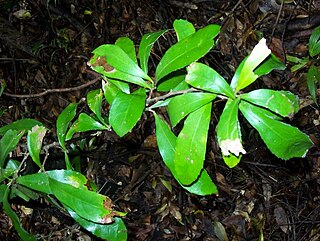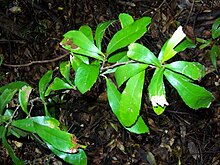
Athertonia is a genus of tall trees, constituting part of the plant family Proteaceae. It is a monotypic taxon, and the sole described species is Athertonia diversifolia, commonly known as Atherton oak. It is a small to medium-sized tree and is endemic to restricted tablelands and mountainous regions of the wet tropics rain forests of north-eastern Queensland, Australia, where it is widespread. For example, it grows in the Atherton Tableland region with which it shares its name, from the colonial pastoralist John Atherton (1837–1913). Its closest relatives are Heliciopsis and Virotia. A relative of the macadamia, it has potential as an ornamental tree and has an edible nut.
Triunia is a genus of medium to tall shrubs or small trees found as understorey plants in rainforests of eastern Australia. Members of the plant family Proteaceae, they are notable for their poisonous fleshy fruits or drupes. Only one species, T. youngiana, is commonly seen in cultivation.
Alloxylon brachycarpum is a species of plant in the family Proteaceae. It is found in Indonesia and Papua New Guinea. It is threatened by habitat loss.
Helicia albiflora is a species of plant in the family Proteaceae. It is endemic to Papua New Guinea. It is threatened by habitat loss.
Helicia amplifolia is a species of plant in the family Proteaceae. It is endemic to Papua New Guinea. It is threatened by habitat loss.
Helicia australasica, also named Austral oak or creek silky oak, is a species of rainforest trees from the flowering plant family Proteaceae.
Helicia calocoma is a species of plant in the family Proteaceae. It is endemic to Papua New Guinea. It is threatened by habitat loss.
Helicia insularis is a species of plant in the family Proteaceae. It is endemic to Papua New Guinea. It is threatened by habitat loss.
Helicia latifolia is a species of plant in the family Proteaceae. It is endemic to Papua New Guinea. It is threatened by habitat loss.
Helicia neglecta is a species of plant in the family Proteaceae. It is endemic to Papua New Guinea. It is threatened by habitat loss.
Helicia peltata is a species of plant in the family Proteaceae. It is endemic to Papua New Guinea. It is threatened by habitat loss.
Helicia polyosmoides is a species of plant in the family Proteaceae. It is endemic to Papua New Guinea. It is threatened by habitat loss. This taxon was described by Don Foreman in 1985.
Helicia retusa is a species of plant in the family Proteaceae. It is endemic to Papua New Guinea.
Helicia subcordata is a species of plant in the family Proteaceae. It is endemic to Papua New Guinea. It is threatened by habitat loss.
Heliciopsis is a genus of about thirteen species of trees, constituting part of the flowering plant family Proteaceae. They grow naturally in Burma, Indo-China, SE. China, Thailand, Peninsular Malaysia, Borneo, Sumatra, Java (Indonesia) and the Philippines. The name means similar to the plant genus Helicia. Its closest relatives are Athertonia (Australia) and Virotia.

Helicia glabriflora is a species of rainforest shrubs or small trees occurring in eastern Australia. Common names include smooth or pale helicia, pale, leather or brown oak. They grow naturally in a variety of different rainforest types from the Illawarra, New South Wales to the Townsville area, Queensland. Of all the global diversity of approximately one hundred Helicia species, this one species naturally grows the furthest south, in the Minnamurra Rainforest and the Robertson area, Illawarra, New South Wales, there observed more on the relatively fertile basalt and alluvial soils.
Helicia recurva is a species of rainforest trees, of northeastern Queensland, Australia, from the flowering plant family Proteaceae.
Helicia blakei, also named Blake's silky oak, is a species of rainforest tree, of northeastern Queensland, Australia, from the flowering plant family Proteaceae.
Helicia nortoniana, also named Norton's silky oak, is a species of rainforest trees, of northeastern Queensland, Australia, from the flowering plant family Proteaceae.
Don Foreman was an Australian botanist who worked on the Monimiaceae and Proteaceae of Australia. He also helped with the editing of selected Flora of Victoria and Flora of Australia Volumes.



